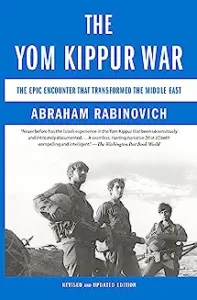The Yom Kippur War: The Epic Encounter that Transformed the Middle East by Abraham Rabinovitch 2004
It was October 5, 1973. The streets of Jerusalem, Tel Aviv, and Haifa were empty and silent as Israel’s Jews observed the holiest day of the year, fasting and praying on Yom Kippur to atone for their sins and seeking to be inscribed in the Book of Life. More than 2650 Israelis would not have that request fulfilled as they lost their lives that day and over the subsequent 18 days when Egypt, Syria, Iraq, and several other Arab nations launched simultaneous attacks from the Suez Canal and the Golan Heights.
The Six Day War in 1967 in which Israel overwhelmed Egyptian, Syrian, and Jordanian forces taking all of the Sinai Peninsula, the Golan Heights, and the Old City of Jerusalem as well as the land all the way to the west bank of the Jordan River, had resulted in an Israel that was arrogant and over-confident, viewing the Arab armies as weak and incompetent. As a result, Israeli intelligence ignored the obvious signs of an Arab offensive growing at Suez and Golan and had only six hours of warning before the war began—a disastrous failure of intelligence and political and military leadership. As a result, in the first four days of the war, Syria came within a few miles of breaking through to Haifa while Egypt placed thousands of soldiers, tanks, and SAM missiles on the east bank of the Canal. Israeli forces were being wiped out at a horrifying rate as the tide of war raged against Israel.
With extra-ordinary bravery on the part of a number of Israeli tank commanders in the Golan and the final abandonment of the misguided strategy to try to hold the Bar Lev line along the canal, reservists called away from synagogue on Yom Kippur began to reach the fronts and by day 4, the tide of battle had turned. The Israelis were on the road to Damascus, and the Egyptians had ceased their forward progress in the Sinai to remain sheltered from the IAF under the cover of their Soviet SAM missile batteries.
The story of how this disastrous opening rout unfolded and how the military and political leadership in Israel (Golda Meir, Moshe Dayan, David Eleazer, and others) finally gained control is the subject of this extra-ordinary book by Rabinovich. With detailed descriptions of the battles and the warriors from generals to infantry men, the author tells this story of an 18 day epic struggle for survival by the Israeli state. A final chapter focuses on lessons learned and the political ramifications of the War.
This is an important subject told with compassion and skill providing geopolitical explanations for Sadat’s bold and unexpected miliary and then diplomatic initiatives as well as the telling details of individuals who left their day jobs as teachers, accountants, attorneys, doctors and took up arms to defend their nation. Our guide in Israel this month told us how he remembered that Yom Kippur day when his father, a reservist paratrooper, and his best friend were drinking tea after synagogue when the air raid siren sounded in Jerusalem. His father turned on the radio where mobilization instructions were being broadcast, put on his uniform and waited outside to be picked up and taken to the mobilization center and then the front. His father fought in Egypt reaching the western side of the Suez Canal and returned. His father’s friend, a tank commander died in the Golan.
At this time of tension and internal threat in Israel, it is important to understand the nation’s history and the background of security concerns. This book appears to be a balanced and well-written account of one of the sentinal events in Israel’s 75 year history.



